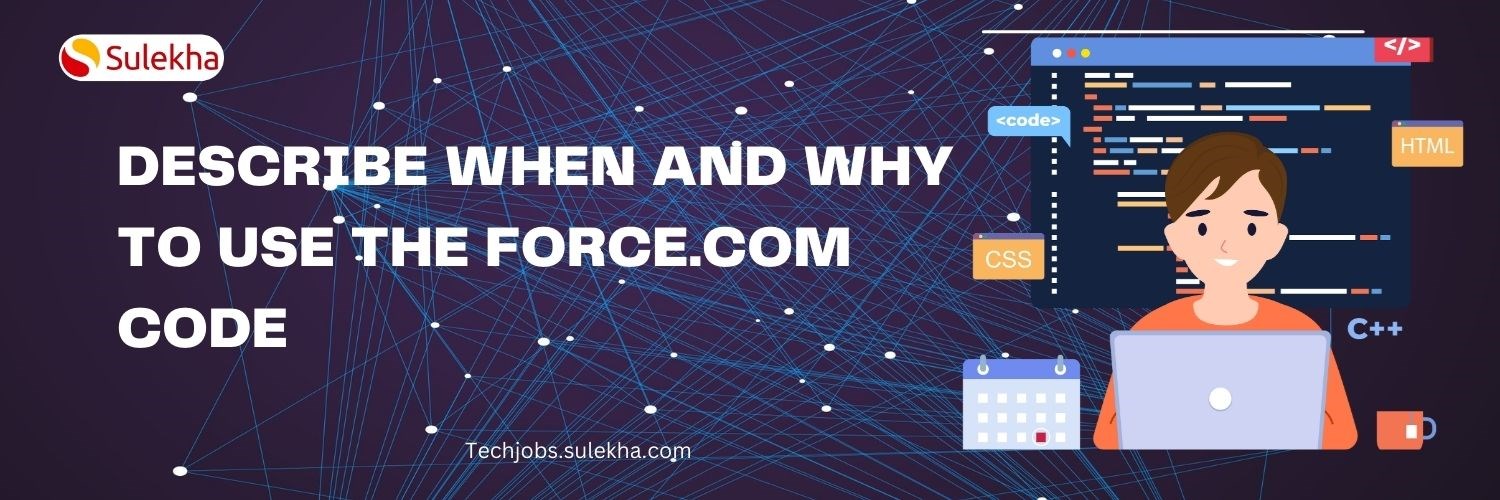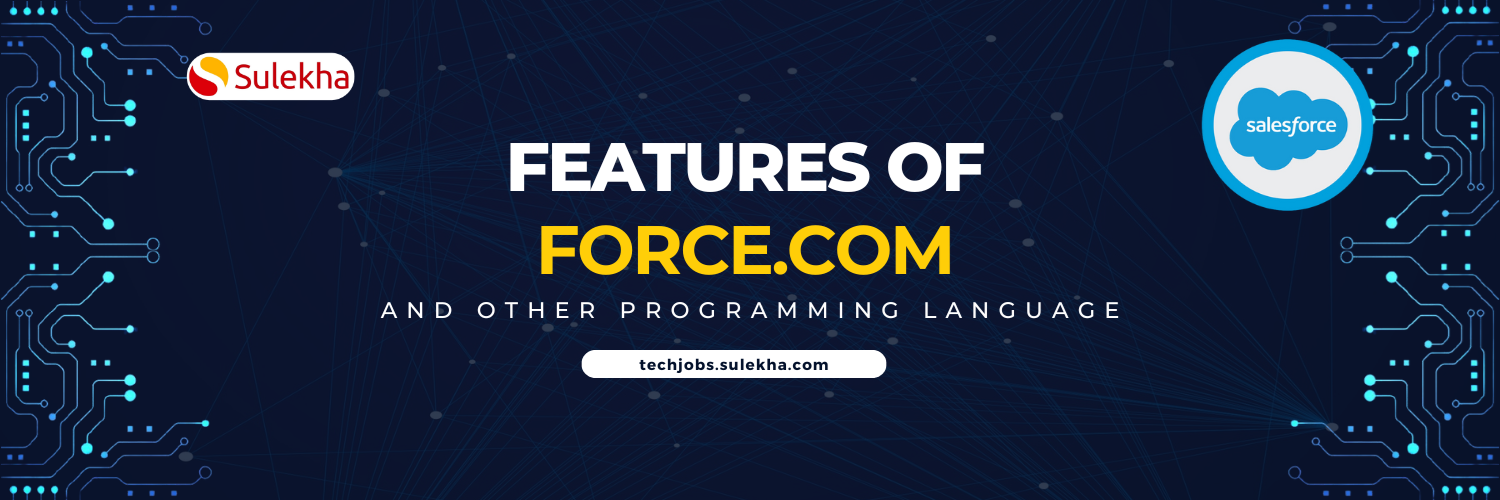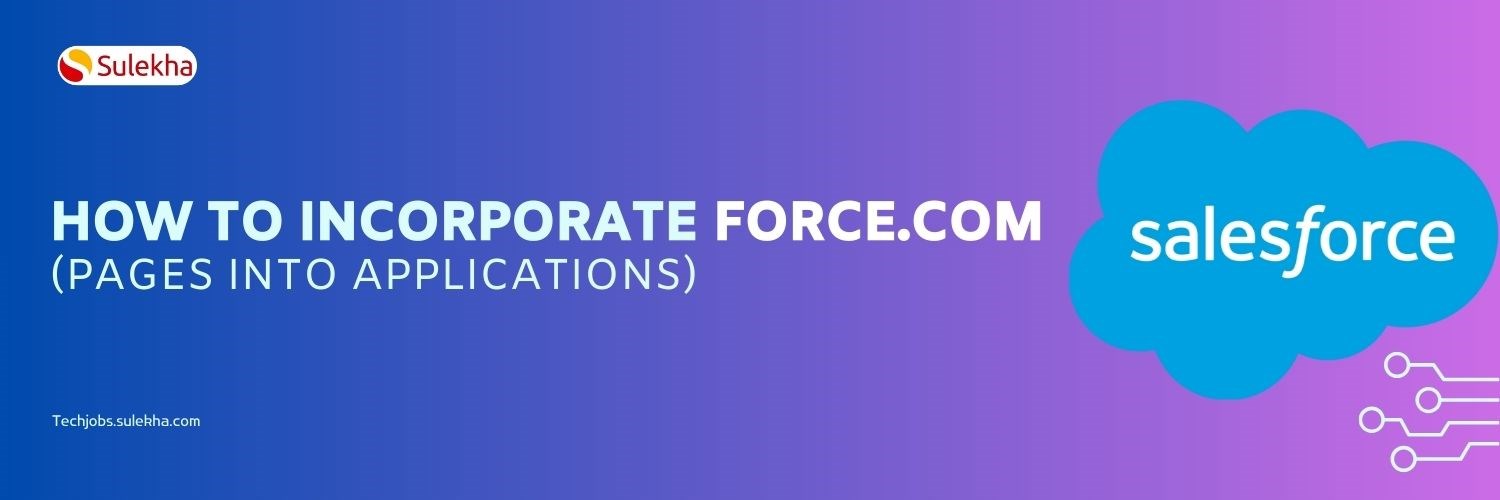List and Describe Syntax Features of Force.com Code

In Salesforce, Apex is the programming language used to create and extend functionalities on the Force.com platform. The syntax of an Apex class in Salesforce closely aligns with the broader syntax features of Force.com code. It follows object-oriented principles, allowing developers to define classes and create instances of those classes as objects.
Salesforce syntax, especially within Apex classes, defines the language structure for creating robust applications on the Force.com platform. In Apex, developers employ object-oriented principles, explicitly declaring variable types in the strongly typed environment. With features like Salesforce Object Query Language (SOQL) and Salesforce Object Search Language (SOSL), developers efficiently interact with the platform's data. Triggers, annotated methods like $$AuraEnabled, and asynchronous processing add versatility, responding to events and enhancing user interfaces.
Mastering the Salesforce syntax, particularly within Apex classes, empowers developers to build scalable, dynamic, and feature-rich solutions seamlessly integrated into the Salesforce ecosystem.
In discussing the syntax features of Force.com code, we will explore several core concepts that form the foundation of building applications on the Force.com platform. Force.com code, primarily written in Apex, is designed to provide a powerful and flexible syntax for building applications on the Salesforce platform.
Here are some key syntax features
Object-Oriented Language: Apex is a programming language that follows the principles of object-oriented programming. This practice enables developers to represent real-world entities by utilizing classes and objects. It facilitates the structuring of code, promotes the reuse of code components, and enhances the ability to extend the code's functionality.
Strongly Typed: Apex is characterized as a strongly typed programming language whose variable types necessitate explicit declaration. Implementing this measure ensures data integrity and mitigates the possible occurrence of runtime errors.
Governor Limits: Force.com enforces governor limits to control the resources consumed by a transaction, preventing abuse and ensuring fair usage in a multi-tenant environment.
SOQL (Salesforce Object Query Language): Apex includes SOQL for querying Salesforce objects, providing a SQL-like syntax to retrieve data. This simplifies data manipulation within the platform.
SOSL (Salesforce Object Search Language): The SOSL (Salesforce Object Search Language) is employed to do searches across different objects within the Salesforce platform. This technology facilitates the effective searching and retrieval of pertinent records through text-based methods.
Triggers: Apex triggers are event-driven codes that execute before or after records are inserted, updated, deleted, or undeleted. This allows developers to respond to changes in data and enforce business logic.
Annotations: Apex supports annotations, such as $$AuraEnabled, for exposing methods to Lightning components, enhancing interoperability with the Lightning framework.
Exception Handling: The Apex programming language incorporates try-catch blocks to facilitate the handling of exceptions, enabling developers to manage failures and maintain their applications' robustness.
Asynchronous Processing: Developers can leverage asynchronous processing with features like $$future annotations and batch processing to handle large volumes of data without impacting user experience.
Visualforce Markup: Apex developers employ Visualforce, a markup language, to construct customized user experiences. This makes it possible to create responsive and dynamic web pages.
Interfaces and Inheritance: The Apex programming language supports interfaces and class inheritance, allowing developers to construct modular code structures that can be extended.
Dynamic Apex: The ability to create and run dynamic code at runtime with Dynamic Apex gives developers the freedom to work with variables, objects, and fields dynamically.
The syntax features of Force.com code, as exemplified by Apex, collectively provide a comprehensive toolkit for developers building applications on the Salesforce platform. From its object-oriented structure for efficient code organization to supporting advanced features like triggers and web services integration, Apex empowers developers to create scalable, dynamic, and data-driven solutions. The imposition of governor limits ensures resource efficiency, while the rich set of control structures and data types allows for implementing complex business logic.
Overall, the syntax features of Force.com code contribute to the platform's adaptability, efficiency, and versatility in addressing a wide range of development needs within the Salesforce ecosystem.
Find a course provider to learn Salesforce
Java training | J2EE training | J2EE Jboss training | Apache JMeter trainingTake the next step towards your professional goals in Salesforce
Don't hesitate to talk with our course advisor right now
Receive a call
Contact NowMake a call
+1-732-338-7323Take our FREE Skill Assessment Test to discover your strengths and earn a certificate upon completion.
Enroll for the next batch
Salesforce Course Online Training
- Dec 18 2025
- Online
Salesforce Course Online Training
- Dec 19 2025
- Online
Related blogs on Salesforce to learn more

INTRODUCTION TO CLINICAL RESEARCH
Learn the fundamentals of clinical trials, and eight phases of the clinical research process.

Describe when and why to use the Force.com code
Discover how to leverage the power of Apex code to automate business processes, enhance user experience, and improve data quality in your Salesforce organization.

Features of Force.com code and distinguish between Force.com code and other programming languages.
Learn how to seamlessly integrate Force.com pages into your Salesforce applications to enhance user experience and discover the steps to create, customize, and deploy custom pages that meet your specific business needs.
An Introduction: Integrating with the Salesforce Force.com Platform
Unlock the full potential of your Salesforce implementation by integrating it with external systems and applications.

Describe How to Incorporate Force.com Pages into Force.com Applications
Learn how to seamlessly integrate Force.com pages into your Salesforce applications to enhance user experience and discover the steps to create, customize, and deploy custom pages that meet your specific business needs.

Describe the save execution order and use of before and after triggers
Learn how to write triggers that execute at the right time to meet your specific business needs

Debugging, Testing, and Monitoring in Force.com: A Comprehensive Guide
Explore the essential techniques for debugging, testing, and monitoring your Force.com applications.
A Comprehensive Guide to Managing Static Resources in Salesforce
We have discussed the types of Static Resources, how to Create & Use Static Resources and best Practices for Managing Static Resources in Salesforce
Introduction to Force.com Sites – Overview
Learn about the features, benefits, and use cases for Force.com Sites, and discover how to create a custom website that integrates with your Salesforce data and workflows.
Distinguish between standard controllers, custom controllers, and extensions
This guide covers the features, benefits, and use cases for each type of controller, helping you to build more efficient and effective Salesforce applications.
Latest blogs on technology to explore

From Student to AI Pro: What Does Prompt Engineering Entail and How Do You Start?
Explore the growing field of prompt engineering, a vital skill for AI enthusiasts. Learn how to craft optimized prompts for tools like ChatGPT and Gemini, and discover the career opportunities and skills needed to succeed in this fast-evolving indust

How Security Classification Guides Strengthen Data Protection in Modern Cybersecurity
A Security Classification Guide (SCG) defines data protection standards, ensuring sensitive information is handled securely across all levels. By outlining confidentiality, access controls, and declassification procedures, SCGs strengthen cybersecuri

Artificial Intelligence – A Growing Field of Study for Modern Learners
Artificial Intelligence is becoming a top study choice due to high job demand and future scope. This blog explains key subjects, career opportunities, and a simple AI study roadmap to help beginners start learning and build a strong career in the AI

Java in 2026: Why This ‘Old’ Language Is Still Your Golden Ticket to a Tech Career (And Where to Learn It!
Think Java is old news? Think again! 90% of Fortune 500 companies (yes, including Google, Amazon, and Netflix) run on Java (Oracle, 2025). From Android apps to banking systems, Java is the backbone of tech—and Sulekha IT Services is your fast track t

From Student to AI Pro: What Does Prompt Engineering Entail and How Do You Start?
Learn what prompt engineering is, why it matters, and how students and professionals can start mastering AI tools like ChatGPT, Gemini, and Copilot.

Cyber Security in 2025: The Golden Ticket to a Future-Proof Career
Cyber security jobs are growing 35% faster than any other tech field (U.S. Bureau of Labor Statistics, 2024)—and the average salary is $100,000+ per year! In a world where data breaches cost businesses $4.45 million on average (IBM, 2024), cyber secu

SAP SD in 2025: Your Ticket to a High-Flying IT Career
In the fast-paced world of IT and enterprise software, SAP SD (Sales and Distribution) is the secret sauce that keeps businesses running smoothly. Whether it’s managing customer orders, pricing, shipping, or billing, SAP SD is the backbone of sales o

SAP FICO in 2025: Salary, Jobs & How to Get Certified
AP FICO professionals earn $90,000–$130,000/year in the USA and Canada—and demand is skyrocketing! If you’re eyeing a future-proof IT career, SAP FICO (Financial Accounting & Controlling) is your golden ticket. But where do you start? Sulekha IT Serv

Train Like an AI Engineer: The Smartest Career Move You’ll Make This Year!
Why AI Engineering Is the Hottest Skillset Right Now From self-driving cars to chatbots that sound eerily human, Artificial Intelligence is no longer science fiction — it’s the backbone of modern tech. And guess what? Companies across the USA and Can

Confidence Intervals & Hypothesis Tests: The Data Science Path to Generalization
Learn how confidence intervals and hypothesis tests turn sample data into reliable population insights in data science. Understand CLT, p-values, and significance to generalize results, quantify uncertainty, and make evidence-based decisions.